This is a commentary and comments are welcome by email to info@eaa.co.ke
EASTERN AFRICA POPULATION DEMOGRAPHICS
Global population trends
With Africa’s (including Eastern Africa’s) population demographics shifting towards the young, it is not surprising that their Gen Zs and Millennials are becoming more active. The trend in Africa is very different from other parts of the world where the median age is significantly higher. The data and charts used in this commentary have been extracted from https://www.worldometers.info/world-population/ and while it may not correspond fully to the various National Censuses, it serves to give a relative picture between countries.
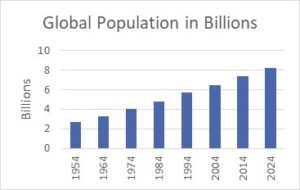
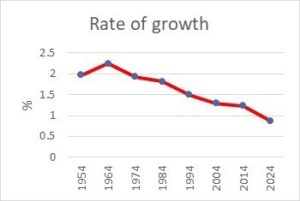
The global population is now at almost 8.2 billion (first chart above) but interestingly, the rate of growth has dropped (see the second chart above). It took 183 years for the global population to reach 1 billion people, but between 1804 and 2022 (218 years), the number of people on earth rose to 8 billion. The current forecast, according to the United Nations, is that the global population will reach approximately 10 billion by 2060 with the median age increasing from 30.6 to 36 years. Other than Africa and Oceania, the rate of growth is slowing globally.
The charts below show the current population and growth rates by Continent:
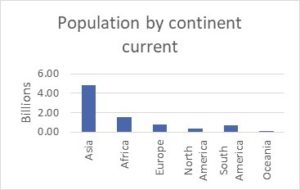
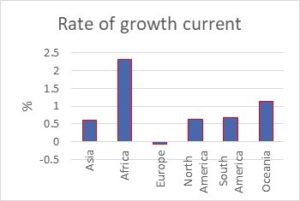
Africa is the outlier in terms of population growth with the current rate being 2.32%. Europe’s population on the other hand is expected to contract by 0.07%. Going more granular, the country with the highest population, India, is expected to grow at 0.89% while China, the second highest population, is contracting by 0.23%, perhaps a function of the one child policy that had been in place for many years.
Eastern Africa
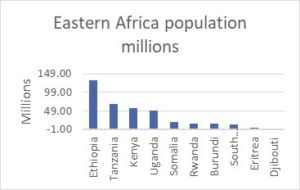
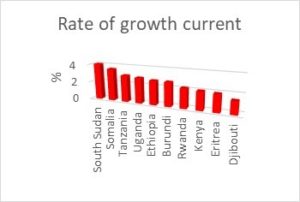
Interestingly, South Sudan, one country in the region facing the largest internal issues, is set to grow at a shade over 4%. Of the 10 countries in the charts above, 8 are members of the East Africa Community (EAC) with a total population of 310 million. The DRC is also a member making the EAC a market of 419 million people, which could present significant opportunity for investment in the region.
The table below sets out the key statistics for the five larger economies in Eastern Africa with a comparison to the world.
|
Population |
Median age |
Fertility rate |
Life expectancy |
Infant mortality / 000 births |
Urban population |
Density / km2 |
|
| Ethiopia | 132.59 | 18.9 | 3.9 | 67.6 | 31.9 | 22.1% | 132 |
| Tanzania | 68.87 | 17.4 | 4.5 | 67.2 | 28.2 | 39.3% | 77 |
| Kenya | 56.43 | 19.8 | 3.2 | 63.8 | 29.0 | 31.3% | 99 |
| Uganda | 50.23 | 16.7 | 4.2 | 68.5 | 27.8 | 29.3% | 250 |
| Rwanda | 14.31 | 19.7 | 3.6 | 68.0 | 26.4 | 18.1% | 578 |
| World | 8,161.97 | 30.6 | 2.2 | 73.3 | 26.9 | 57.5% | 55 |
Perhaps the key inference that can be drawn from this is that Eastern Africa has a relatively young population when compared to the world as a whole. The average median age is 18.5 years compared to the world one, of 30.6 years and 19.2 for Africa as whole. The wider Eastern Africa, according to Worldometer, ranks highest in Africa by population.
The United Nations Economic Commission for Africa, in a blog issued in July 2024 by Saurabh Sinha (Chief of Social Policy Section) and Melat Getachew (Consultant), said: “Africa has been at the centre of this population growth – accounting for the largest relative growth, its population has expanded from 283 million in 1960 to more than 1.5 billion in 2024 – a more than five-fold increase – and is projected to increase by 950 million and touch 2.5 billion by 2050”. Indeed, by 2050 it is estimated that of the top 8 countries in the world that will account for half of the world’s population, 5 will be African, including Tanzania.
This rapid increase in Africa’s population is attributed to a four-fold decline in infant mortality rates in the last 64 years and life expectancy increasing from 43 to 66 years, which is expected to rise to 70 years by 2050.
“Africa’s future is bright with the potential to realise a demographic transition and a large demographic dividend by the middle of this century when the ratio of working-age persons to dependents, an indicator of the demographic transition, reaches 1.7:1 by 2050 at which level the countries are well placed to realise a demographic dividend”. Blog by Saurabh Sinha and Melat Getachew, ECA
But to take full advantage of the demographic dividend, Governments on the Continent, and indeed Eastern Africa, need to focus on their policies for education and health. Strong institutions are going to be needed all across Africa; however, current trends do not make one optimistic. There is huge opportunity that Governments will have to capitalise on, or the Continent will remain dormant.
The youth
According to the United Nations, 70% of Africa’s population are under the age of 30. In an article titled: “Young People’s Potential, the Key to Africa’s Sustainable Development” by Jason J Mulikita, UN Youth Envoy, he comments on this significant statistic saying: “Such a high number of young people is an opportunity for the Continent’s growth – but only if these new generations are fully empowered to realise their best potential. It is especially important that young people are included in decision making and given appropriate opportunities for work and to innovate”. In a sense, this is exactly what Kenya’s Gen Z uprising was all about.
In Eastern Africa, the majority of the population is below the age of 35 which presents significant opportunities but also a plethora of challenges to the Governments in the region. There does appear to be a general sense of dissatisfaction among this section of the population which is being seen across the region. Unemployment levels are extremely high, and yet the number of educated youth has increased.
A number of this demographic leave their home country for greener pastures which is both advantageous and disadvantageous. On one front, the region is facing a brain drain which creates a vacuum in the workforce that is not being filled and impacts economic growth. On the other, those that do migrate remain patriotic to their country of birth and remit significant amount of funds back home to support their families. But is this the solution for the region?
It is becoming important for the current political leaders in the region to properly deal with the grievances raised by the youth or else face the increasing upheaval that they could cause. Unfortunately, the leadership in the region does not seem to appreciate this and lack the empathy that is needed to address the plight of the under 35s.
Future elections across the region are likely to see this demographic come out of their apathy and register to vote. The question for them must be who they will vote for because their attitude for the current leadership is one of disdain. Yet the majority of them do not seem ready to step into the world of politics and without this, change may never happen in Eastern Africa and indeed the rest of the Continent.
“Political power lies in the hands of aging leaders who have little knowledge or interest in the ambitions and concerns of younger generations – and sadly even less interest in passing on the reins of leadership”. Mo Ibrahim, Founder and Chair of the Mo Ibrahim Foundation
In a blog post in March 2023 by Ambassador Mark A Green, the President and CEO of the Wilson Centre, Africa’s median age is in the region of 19 but the leaders median age is 63. This significant difference between the leadership and its population is probably the cause of what ails most of the Continent. In a Special with CNN in September 2013, he had the foresight to ask: “Africa must ask itself why our Continent appears so frightened of giving the younger generation a chance”.
Perhaps it is the high number of youths that scares African Governments but in times of an information overload and the young who are extremely tech savvy, change has to come.
The future for Eastern Africa
While we do not have a crystal ball, it is clear that the changing demographics in Eastern Africa’s population and its youth bulge, mean Governments are going to have to rethink their approach. Aya Chebbi, Founder of Nalafem and Former African Union Special Envoy on Youth and Mamphela Ramphele, Honorary President of The Club of Rome summed up the issue saying in January this year: “Africa’s adult population can be divided roughly into three generations: the independence generation that lived through colonial rule and subsequent liberation; the multiparty system generation; and the younger generations that, in recent years, have led uprisings for change”.
It is the younger generation referred to above that will shape the future of Eastern Africa and the Continent as a whole and this will not be pretty should the “multiparty system generation” ignore them! The consequences of doing this will be far reaching.
This is a commentary and comments are welcome by email to info@eaa.co.ke
